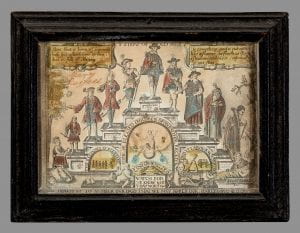Ye Steps of Old Age: New Research, and New Beginnings
By Molly Mapstone, Class of 2021

Ye STEPS OF OLD AGE print. Printed between 1650 and 1700 in England by engraving and etching. It contains an ink inscription, “Mary Russell”, who once owned the print but died in Boston in 1735 . It was hand-colored with paint and mica sometime between 1750 and 1800. Image courtesy of the Winterthur Museum, 1969.0838A.
Leaving a beloved job, your friends, and the city where you spent most of your young adulthood is difficult, no matter how wonderful the opportunities ahead are. In order to start my journey as a Winterthur Material Culture Fellow I obviously had to leave where I came from to be here. Initially, when tasked to choose just one object to follow me for a summer and semester, I was overwhelmed. How would I know what to pick, or what was truly the right choice? I was worried that choosing “the wrong” object would divert my career path in the wrong direction, or no direction at all. For a while, I went back and forth between a couple of things but ultimately at the very last second (actually, past the official deadline), I remembered a strange little print tucked away in a remote room on the 8th floor of Winterthur.
I had just left my job in the print room at the Chazen Museum of Art in Madison, Wisconsin and was missing being around the prints every day that I had become so familiar with. Being away from the prints, I realized that I wanted to know more; more about the history of printmaking, print culture, and how prints are made. This print had caught my eye because of its strange colors and other materials on top of the ink. I also wanted to learn more about the imagery of the print. I had seen other prints online that depicted the stages of life, but there were none that I had ever seen in the collection I was working in. I saw this as an opportunity to fill in some of the gaps I had in my education of print history.
Ultimately, my research on this print has left me with more questions than answers. I tracked down an essay containing a reference to this print using the museum’s registrar files and from there found that depicting the steps of life on a stepped pyramid is part of a larger trend in popular print making.[2] Additionally, through a combination of close looking and consulting the conservation files, I found that this print has undergone extensive changes in its lifetime. It has been colored, damaged, glittered, and written on. While I may not have made groundbreaking conclusions on the factual history of this object now, I have speculated as to why it has been so well-loved, or damaged, it depends on your outlook. Perhaps the passage of the male figure from birth to death, changing in each stage, holding new props and sporting new outfits, points to a continual interest we all share in thinking about where we are going and what is coming next. In this print we see where the boy was, and where he has gone. It is comforting to see such a neat and well prescribed life-path, and that his life seems to have gone smoothly. As I enter the Winterthur Program in Material Culture, I ask frequently myself similar questions: where am I, what am I doing here, and where am I going?
Next semester, I hope to uncover the makers of this object, delve into the mysterious owner Mary Russell, and research the hand-coloring and mica more to get a more concrete sense of this print’s life and its multiple makeovers. This object will serve as a concrete touchstone in the start of my career in material culture, as it may have helped guide others in their life as they too wondered where they were going, and what was coming next.
[1] E. McSherry Fowble, Two Centuries of Prints in America, 1680-1880: A Selective Catalogue of the Winterthur Museum Collection (Charlottesville: Published for the Henry Francis du Pont Winterthur Museum by the University Press of Virginia, 1987).
[2]Michael Kammen, “Changing Perceptions of the Life Cycle in American Thought and Culture,” Proceedings of the Massachusetts Historical Society 91 (1979): 35–66, 52.


Leave a Reply